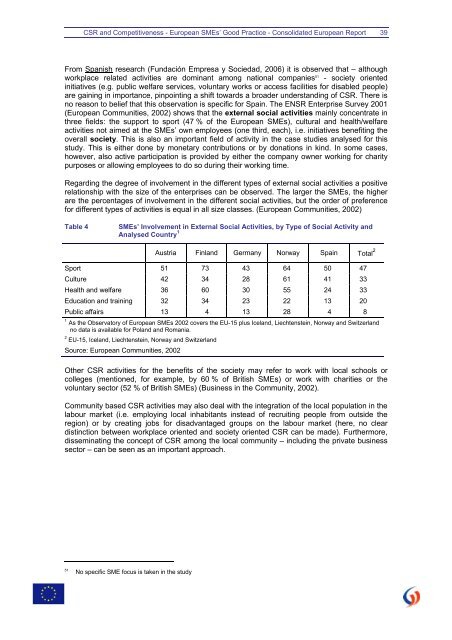CSR and Competitiveness European SMEs - KMU Forschung Austria
CSR and Competitiveness European SMEs - KMU Forschung Austria
CSR and Competitiveness European SMEs - KMU Forschung Austria
Create successful ePaper yourself
Turn your PDF publications into a flip-book with our unique Google optimized e-Paper software.
<strong>CSR</strong> <strong>and</strong> <strong>Competitiveness</strong> - <strong>European</strong> <strong>SMEs</strong>’ Good Practice - Consolidated <strong>European</strong> Report 39<br />
From Spanish research (Fundación Empresa y Sociedad, 2006) it is observed that – although<br />
workplace related activities are dominant among national companies 51 - society oriented<br />
initiatives (e.g. public welfare services, voluntary works or access facilities for disabled people)<br />
are gaining in importance, pinpointing a shift towards a broader underst<strong>and</strong>ing of <strong>CSR</strong>. There is<br />
no reason to belief that this observation is specific for Spain. The ENSR Enterprise Survey 2001<br />
(<strong>European</strong> Communities, 2002) shows that the external social activities mainly concentrate in<br />
three fields: the support to sport (47 % of the <strong>European</strong> <strong>SMEs</strong>), cultural <strong>and</strong> health/welfare<br />
activities not aimed at the <strong>SMEs</strong>’ own employees (one third, each), i.e. initiatives benefiting the<br />
overall society. This is also an important field of activity in the case studies analysed for this<br />
study. This is either done by monetary contributions or by donations in kind. In some cases,<br />
however, also active participation is provided by either the company owner working for charity<br />
purposes or allowing employees to do so during their working time.<br />
Regarding the degree of involvement in the different types of external social activities a positive<br />
relationship with the size of the enterprises can be observed. The larger the <strong>SMEs</strong>, the higher<br />
are the percentages of involvement in the different social activities, but the order of preference<br />
for different types of activities is equal in all size classes. (<strong>European</strong> Communities, 2002)<br />
Table 4 <strong>SMEs</strong>’ Involvement in External Social Activities, by Type of Social Activity <strong>and</strong><br />
Analysed Country 1<br />
<strong>Austria</strong> Finl<strong>and</strong> Germany Norway Spain Total 2<br />
Sport 51 73 43 64 50 47<br />
Culture 42 34 28 61 41 33<br />
Health <strong>and</strong> welfare 36 60 30 55 24 33<br />
Education <strong>and</strong> training 32 34 23 22 13 20<br />
Public affairs 13 4 13 28 4 8<br />
1<br />
As the Observatory of <strong>European</strong> <strong>SMEs</strong> 2002 covers the EU-15 plus Icel<strong>and</strong>, Liechtenstein, Norway <strong>and</strong> Switzerl<strong>and</strong><br />
no data is available for Pol<strong>and</strong> <strong>and</strong> Romania.<br />
2<br />
EU-15, Icel<strong>and</strong>, Liechtenstein, Norway <strong>and</strong> Switzerl<strong>and</strong><br />
Source: <strong>European</strong> Communities, 2002<br />
Other <strong>CSR</strong> activities for the benefits of the society may refer to work with local schools or<br />
colleges (mentioned, for example, by 60 % of British <strong>SMEs</strong>) or work with charities or the<br />
voluntary sector (52 % of British <strong>SMEs</strong>) (Business in the Community, 2002).<br />
Community based <strong>CSR</strong> activities may also deal with the integration of the local population in the<br />
labour market (i.e. employing local inhabitants instead of recruiting people from outside the<br />
region) or by creating jobs for disadvantaged groups on the labour market (here, no clear<br />
distinction between workplace oriented <strong>and</strong> society oriented <strong>CSR</strong> can be made). Furthermore,<br />
disseminating the concept of <strong>CSR</strong> among the local community – including the private business<br />
sector – can be seen as an important approach.<br />
51 No specific SME focus is taken in the study




